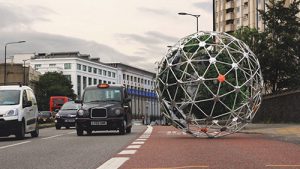Few of us are lucky enough to have a green thumb. The perfect balance of sunlight, climate, and water requires a special, intuitive touch. A little too much water, a little too little, and turns into gunk or withers. A little too much sun, a little too little, and wastes away and shrivels. And, so it goes.
Well, gardening just got a little easier. According to Inhabitat, students at University College London’s Interactive Architecture Lab have designed a nomadic, self-driving, and self-cultivating garden named Hortum machina, B. Like an autonomous car, the mobile garden responds to the environment, in this case, moving towards or away from sunlight, shade, and unhealthy levels of air pollution, as needed.
The moving ecosystem is encased in a large geodesic sphere that uses a network of electrodes to monitor the garden’s physiological responses, using this data to determine its movements.
Hortum machina, B was tested in London and is quite self-sufficient—powered by an attached solar panel and supplied with a built-in water storage.
The experimental project was executed with the intent to explore options to expand London’s green space.
Earlier in the year, researchers at Iowa State University also worked to create easier gardening conditions, but this time focusing on assisting farmers. The scientists developed “plant tattoo sensors,” sensors on tape that attach to plants to provide water data to researchers and farmers. All of these innovative designs just the peak of a push towards a greener, renewable future.



